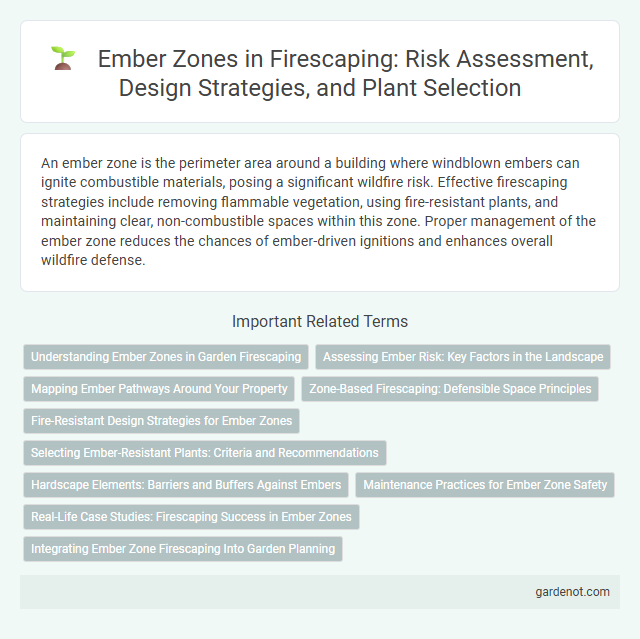An ember zone is the perimeter area around a building where windblown embers can ignite combustible materials, posing a significant wildfire risk. Effective firescaping strategies include removing flammable vegetation, using fire-resistant plants, and maintaining clear, non-combustible spaces within this zone. Proper management of the ember zone reduces the chances of ember-driven ignitions and enhances overall wildfire defense.
Understanding Ember Zones in Garden Firescaping
Ember zones are high-risk areas surrounding a property where wind-blown embers can ignite combustible materials, making strategic plant selection and placement crucial for garden firescaping. Maintaining a defensible space by clearing dry leaves, mulch, and highly flammable vegetation within ember zones reduces the likelihood of fire entry into homes. Incorporating fire-resistant plants with high moisture content and minimal resin or oils enhances the garden's resilience against ember-driven wildfires.
Assessing Ember Risk: Key Factors in the Landscape
Ember zones are areas within 1,000 feet of a property where embers from wildfires can ignite structures and vegetation. Assessing ember risk involves evaluating factors such as vegetation density, fuel types, topography, and proximity to existing fires. Mitigating ember risk requires strategic placement of defensible space, use of fire-resistant materials, and ongoing maintenance to reduce combustible elements in vulnerable zones.
Mapping Ember Pathways Around Your Property
Mapping ember pathways around your property is crucial in firescaping to prevent wildfires from igniting structures. Identify areas where wind-carried embers can travel, such as gaps in roofing, vents, and spaces under decks, and create defensible spaces by removing flammable materials. Use non-combustible barriers and vegetation buffers to disrupt ember flow and protect vulnerable zones.
Zone-Based Firescaping: Defensible Space Principles
Ember zones, located closest to structures, require meticulous firescaping that emphasizes Zone-Based Firescaping and Defensible Space Principles to prevent ignition from windborne embers. Vegetation management involves maintaining low-flammability plants, pruning tree canopies to increase vertical and horizontal spacing, and removing dead or dry debris to reduce fuel loads. Strategic placement of hardscape features and fire-resistant materials enhances the safety of ember zones by creating effective fuel breaks and minimizing ember accumulation.
Fire-Resistant Design Strategies for Ember Zones
Designing fire-resistant ember zones involves using non-combustible materials such as metal, brick, or stone for decks, fences, and siding within 100 feet of the home. Installing ember-resistant vents and sealing gaps around windows and doors significantly reduces the risk of ember intrusion. Maintaining defensible space by clearing flammable vegetation and debris enhances the overall ember zone's protection against wildfires.
Selecting Ember-Resistant Plants: Criteria and Recommendations
Selecting ember-resistant plants involves prioritizing species with high moisture content, low resin levels, and minimal dead material to reduce fire risk in the ember zone. Native succulents, deciduous trees with broad leaves, and well-maintained shrubs with dense, compact foliage are recommended for their ability to withstand embers and flames. Incorporating fire-resistant plants such as manzanita, California lilac, and aloe vera enhances defensible space and supports effective firescaping strategies.
Hardscape Elements: Barriers and Buffers Against Embers
Hardscape elements such as stone walls, concrete paths, and gravel beds serve as effective barriers and buffers against ember intrusion in the ember zone. These non-combustible materials reduce the likelihood of ember ignition by interrupting the fuel continuity and providing clear defensible space around structures. Incorporating fire-resistant hardscape features is crucial in ember zone firescaping to enhance property protection and minimize fire spread risk.
Maintenance Practices for Ember Zone Safety
Regular removal of dry leaves, pine needles, and other combustible materials within the ember zone significantly reduces fire risk by limiting potential fuel sources. Maintaining well-trimmed vegetation and ensuring that tree branches are cut back at least 10 feet from structures prevent ember intrusion into vulnerable areas. Routine inspection and cleaning of gutters, roof edges, and vents minimize ember accumulation, enhancing overall ember zone safety and fire resilience.
Real-Life Case Studies: Firescaping Success in Ember Zones
Firescaping in ember zones significantly reduces wildfire hazards by incorporating fire-resistant plants and strategic landscaping designs that block ember penetration. Real-life case studies from regions like California's wildfire-prone areas demonstrate how creating defensible spaces with ember-resistant vegetation and non-flammable hardscape elements has prevented structural ignitions. These successful implementations showcase measurable decreases in property loss and improved community resilience against ember-generated spot fires.
Integrating Ember Zone Firescaping Into Garden Planning
Integrating ember zone firescaping into garden planning involves strategically selecting fire-resistant plants and designing defensible spaces within the high-risk ember zone. Emphasizing non-combustible hardscape elements and maintaining clear, well-spaced vegetation reduces ember accumulation and fire spread. Incorporating hardscaping materials such as gravel, stone, and concrete pathways further enhances ember zone resilience and protects property during wildfires.
Ember zone Infographic

 gardenot.com
gardenot.com